The Country That Produces The Most Tuna In The World
Tuna is one of the most popular fish in the world, and its market is expected to reach $52.85 billion by 2028 (via Globe Newswire). This popularity is driven, in part, by demand for canned tuna varieties that are affordable, ready to eat, and very shelf-stable. Currently, Indonesia is the world's largest tuna producer, with a 15% share of market production. Indonesia's ability to lead tuna production stems from its location, which gives it access to the abundant schools of tuna in both the Pacific and Indian oceans. Most notably, the waters around Indonesia are fantastic fishing grounds for yellowfin and bluefin tuna, as well as albacore.
However, despite being the world's largest tuna producer, Indonesia doesn't manufacture the most canned tuna. That title goes to Thai Union in Thailand. As the world's biggest producer of canned tuna, Thai Union sources its fish from across the globe, though Indonesia is one of its primary import sources.
Unfortunately, fisheries in Indonesia have begun facing several challenges in recent years, largely due partly to unregulated and illegal fishing practices that have severely depleted tuna populations. This population decline has the potential to significantly impact the country's economy, given that tuna fisheries are responsible for 2.65% of their GDP according to a review in the academic journal Marine Policy. While Indonesia has taken steps to address illegal, unreported, and unregulated fishing, other crimes tied to the industry, including human trafficking and forced labor, have further increased the need for additional measures and increased international and local cooperation.
The dark side to Indonesia's tuna industry and how it's changing
The darker side of Indonesia's tuna fishing industry first gained widespread attention in 2015 when the Associated Press published a year-long investigation into the use of slave labor in Benjina, Indonesia. Speaking with several current and former slaves, the Associated Press painted a harrowing picture of how exploited human labor contributed to the South Asian fishing industry. Moreover, because the seafood caught by slaves was mixed with other fish at various processing plants, it became nearly impossible to trace. In the end, several supply chains ended up tainted by these criminal practices.
In 2021, Greenpeace published Forced Labour At Sea: The Case of Indonesian Migrant Fishers, a report that demonstrated that extreme human rights violations are still very prevalent in Indonesia's tuna fishing industry, with some fishermen being forced to work as many as 22 hours per day for little or no pay.
That said, strides have been made in recent years toward ethical sourcing, labor practices, and traceability. Notably, the Indonesian Pole & Line and Handline Fisheries Association has become a major player in regard to the sustainability of tuna populations, and it works with over 800 registered pole and line fishermen. Additionally, Indonesia has begun developing tuna farming in order to mitigate the decline of wild populations. Fisheries like these will also help Indonesia obtain eco and sustainability labeling on tuna products they produce. Since 2019, Indonesian President Joko Widodo has pushed for further aquaculture productivity, and by 2021, the country was outputting 12.25 metric tons of tuna through farming (via Mongabay).

